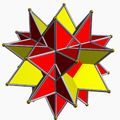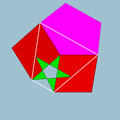The vertex figure of a polyhedron
The relations can be made apparent by examining the vertex figures obtained by listing the faces adjacent to each vertex (remember that for uniform polyhedra all vertices are the same, that is vertex-transitive). For example, the cube has vertex figure 4.4.4, which is to say, three adjacent square faces. The possible faces are
- 3 – equilateral triangle
- 4 – square
- 5 – regular pentagon
- 6 – regular hexagon
- 8 – regular octagon
- 10 – regular decagon
- 5/2 – pentagram
- 8/3 – octagram
- 10/3 – decagram
Some faces will appear with reverse orientation which is written here as
- −3 – a triangle with reverse orientation (often written as 3/2)
Others pass through the origin which we write as
- 6* – hexagon passing through the origin
The Wythoff symbol relates the polyhedron to spherical triangles. Wythoff symbols are written p|q r, p q|r, p q r| where the spherical triangle has angles π/p,π/q,π/r, the bar indicates the position of the vertices in relation to the triangle.

Johnson (2000) classified uniform polyhedra according to the following:
- Regular (regular polygonal vertex figures): pq, Wythoff symbol q|p 2
- Quasi-regular (rectangular or ditrigonal vertex figures): p.q.p.q 2|p q, or p.q.p.q.p.q, Wythoff symbol 3|p q
- Versi-regular (orthodiagonal vertex figures), p.q*.−p.q*, Wythoff symbol q q|p
- Truncated regular (isosceles triangular vertex figures): p.p.q, Wythoff symbol q 2|p
- Versi-quasi-regular (dipteroidal vertex figures), p.q.p.r Wythoff symbol q r|p
- Quasi-quasi-regular (trapezoidal vertex figures): p*.q.p*.−r q.r|p or p.q*.−p.q* p q r|
- Truncated quasi-regular (scalene triangular vertex figures), p.q.r Wythoff symbol p q r|
- Snub quasi-regular (pentagonal, hexagonal, or octagonal vertex figures), Wythoff symbol p q r|
- Prisms (truncated hosohedra),
- Antiprisms and crossed antiprisms (snub dihedra)
The format of each figure follows the same basic pattern
- image of polyhedron
- name of polyhedron
- alternate names (in brackets)
- Wythoff symbol
- Numbering systems: W – number used by Wenninger in polyhedra models , U – uniform indexing, K – Kaleido indexing, C – numbering used in Coxeter et al. 'Uniform Polyhedra'.
- Number of vertices V, edges E, Faces F and number of faces by type.
- Euler characteristic χ = V − E + F
The vertex figures are on the left, followed by the Point groups in three dimensions#The seven remaining point groups, either tetrahedral Td, octahedral Oh or icosahedral Ih.




































































































